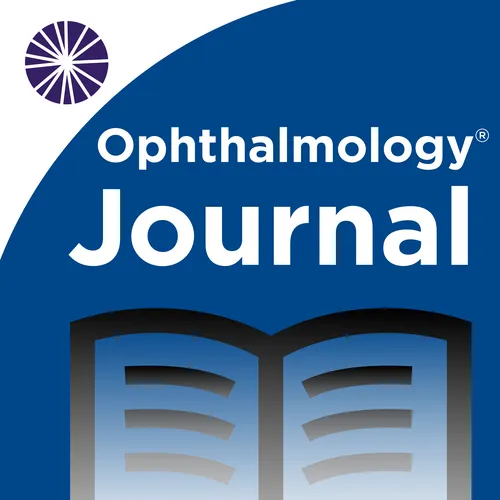
Ophthalmology Journal
Join Ophthalmology’s social media editors as they interview authors and editors of the American Academy of Ophthalmology’s journal family: Ophthalmology, Ophthalmology Retina, Ophthalmology Glaucoma, and Ophthalmology Science.
- Update frequency
- every 13 days
- Average duration
- 22 minutes
- Episodes
- 91
- Years Active
- 2022 - 2025

Peer Review in Ophthalmology and the Council of Vision Editors Fellow Program
Why is peer review important? Is AI changing peer review? How can you become a better peer reviewer? Find out in this special episode, with our newest host and Social Media Editor, Dr. Emily Schehlei…

Plasma Exchange in Optic Neuritis Hospitalizations
Dr. Drew Carey interviews Dr. John J. Chen on the trends and use patterns of plasma exchange therapy for optic neuritis, from his Ophthalmology article, “Trends in Plasma Exchange Use in Optic Neurit…

cfDNA in Ocular Histiocytosis
Dr. Rajesh Rao speaks with Dr. Jasmine H. Francis on whether sequencing of plasma-derived ctDNA can noninvasively diagnose ocular-involving histiocytosis. From her Ophthalmology Science article, “Pla…

AI for Pediatric Pseudopapilledema and True Papilledema
Can artificial intelligence distinguish between pseudopapilledema and true papilledema in children? Dr. Drew Carey interviews author Dr. Melinda Y. Chang on whether AI can be used to improve the diag…

Evaluating Primary Treatment for People with Advanced Glaucoma
Does primary trabeculectomy or medical treatment produce better outcomes in terms of quality of life, clinical effectiveness, and safety in patients with advanced glaucoma? Dr. Drew Carey interviews …

Ophthalmology Education in Medical Schools
How has ophthalmology medical education changed over time in medical school curriculums? Dr. Edmund Tsui speaks with Drs. Ashish Agar and Sascha Spencer on their review of global trends in medical sc…

Adverse Events with Opioids and Ophthalmic Surgery
Ophthalmologists are not spared from the opioid epidemic. Recent studies have shown that opioids continue to be prescribed after ophthalmic surgeries. Dr. Drew Carey interviews Dr. Matthew R. Starr o…

CRISPR Assay for Fungal Keratitis
The RID-MyC assay, a CRISPR/Cas12a-based test, offers swift and reliable detection of Fungal Keratitis, enhancing diagnostic capabilities at point-of-care settings. Dr. Rajesh Rao interviews Dr. Sidd…

Bevacizumab in High-Risk Penetrating Keratoplasty
Dr. Matt Feng is joined by Dr. Thomas H. Dohlman to discuss the effectiveness of topical and subconjunctival bevacizumab in suppressing vascularization in graft and host bed after high-risk corneal t…

Hearing Dysfunction with Teprotumumab
What does hearing dysfunction have to do with an ophthalmology podcast? Listen up and find out as Dr. Drew Carey interviews Dr. Jamie A. Keen and Dr. Erin M. Shriver on the risks of using teprotumuma…

Recurrent Retinal Redetachment after Cataract Surgery
Dr. Matt Feng interviews Drs. Bita Momenaei and Jason Hsu on the incidence, timing, risk factors, and outcomes of recurrent retinal detachment after phacoemulsification, from their Ophthalmology Reti…

Private Equity & Ophthalmology: Spending and Services After Acquisition
Private equity (PE) firms acquired over 200 ophthalmology and optometry practices in the United States from 2021 through 2019. Dr. Rajesh Rao interviews author Dr. Gary Joseph Lelli about the implica…

Efficacy of Carbonic Anhydrase in Patients with X-Linked Retinoschisis
X-linked retinoschisis is a relatively common inherited retinal degenerative disease that almost exclusively affects males. No curative medical therapy is available for this condition, however topica…

Aqueous Macrophages Contribute to Conserved CCL2 & CXCL10 Gradients in Uveitis
Uveitis is a heterogenous group of inflammatory eye diseases for which current cytokine-targeted immune therapies are effective for only a subset of patients. Dr. Edmund Tsui is joined by Dr. Lynn M.…

Vitamin A Deficiency Retinopathy
Vitamin A deficiency is the leading cause of preventable childhood blindness worldwide, but how does this deficiency present itself in a clinical setting? Dr. Drew Carey finds out as he interviews Dr…

Outcomes and Complications after IOL Exchange
An analysis of the IRIS® Registry shows IOL exchanges are increasing over time with vision improving 60% of the time, but worse visual outcomes associated with greater age, worse baseline vision, Bla…

Ophthalmology Workforce Projections, 2020-2035
The Department of Health and Human Services, Health Resources and Services Administration’s Health Workforce Simulation Model forecasts a sizeable shortage of ophthalmology supply relative to demand …

The Effect of Scleral Buckle Surgery on Glaucoma Risk
Scleral buckling is a common surgical procedure for the repair of rhegmatogenous retinal detachment. The association between scleral buckling and angle-closure glaucoma is well-documented. However,th…

Neuro-Ophthalmology Consultations
Neuro-ophthalmology consultations are critical to the diagnosis and management in the hospital setting. Prompt consultation prevents diagnostic errors and improves patient outcomes. The scarcity of n…

Presentation & Outcomes of Acute Syphilitic Posterior Placoid Chorioretinopathy
Syphilis is often known as the “the great masquerader” because it can mimic symptoms and look like a wide array of other diseases. Dr. Edmund Tsui interviews Dr. Michael Huvard to get to the bottom o…